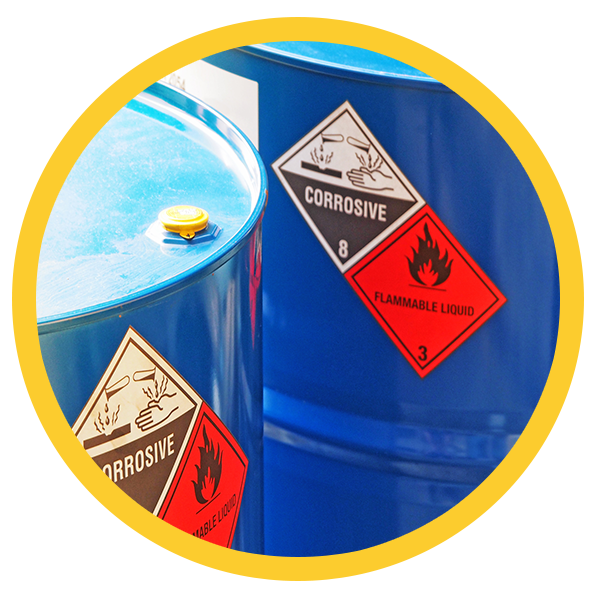Understand the Dangers of Hazardous Materials
A hazardous material is any item or agent (biological, chemical or physical), which has the potential to cause harm to humans, animals or the environment, either by itself or through interaction with other factors. Examples of hazardous materials include chemicals, toxic agents, corrosives, combustible or flammable chemicals.

Hazardous materials can damage the skin, lungs and eyes and in extreme cases cause explosions and fires. It is important to ensure your employees understand the dangers of hazardous materials, know how they should be stored and wear the proper protective equipment when exposed to them.
Below are three steps you can take to ensure the safety of your employees when dealing with hazardous materials.

1. BE PROACTIVE
It is natural to think of a hazardous material as "harmless" when it has been stored without problem for a number of years, but this can have harmful consequences. Hazardous materials, even when stored correctly can cause significant damage in the event of a leak or explosion. Don't neglect these storage containers and have them checked regularly for leaks or other potential problems. Taking this precaution can save lives and prevent incidents.

2. THINK OUTSIDE THE BOX
Abiding by and following the regulations for storing hazardous materials is a must to ensure safety. However, you should look beyond the regulations and ask additional questions to help assess the risk of hazardous materials in your facility.
What material is being stored?
Understand the physical and chemical properties of the hazardous material being stored. Additionally, know what substances and conditions are incompatible and could cause a potential incident.
Consult a General Chemical Resistance Guide like this one from DuPont to understand a chemical?s rating.
Why is the material being stored?
Review and conduct a risk assessment to determine ways to eliminate or reduce the risk in your facility. For example, a just-in-time inventory approach where goods are received as they are needed reduces the quantity of hazardous materials on-site.
Where is the material being stored?
Ensure that "storage" is clearly defined as a permanent, temporary or transient location. This includes any area a container is kept when the storage area is full, which is often the most dangerous and vulnerable location because it is not expected. Also, be aware of processes that take place in areas adjacent to or near the storage location, which may affect the integrity of safely stored materials.
How is the material being handled and stored?
Assess how the material is being moved and handled and what safety improvements can be made. For example, it may be safer to move a pallet with one large container than a pallet with four smaller drums. Also, review how the material is being stored and the environmental conditions required for maximum safety.

3. TAKE EVERY PRECAUTION
When removing hazardous waste, you must ensure your employee's take every precaution to avoid injury. Here are the things to consider:
Depending on the substance you are dealing with, you run the risk of getting a simple rash to severe chemical burns, if not properly protected. Ensure that your skin is protected and wear new gloves every time you handle hazardous waste.
Inhaling dangerous chemicals and materials can be deadly, so protect your lungs and inner body with a good respirator.
Hazardous liquids and gasses have the potential to cause irritation or even blindness. A pair of heavy-duty goggles protects you from this risk.
Hazardous liquids and gasses have the potential to cause irritation to the skin. Wearing protective clothing can help protect against this risk.
OSHA's 1910.22(a)(2) General Requirements for Walking-Working Surfaces was established to ensure that every work room has clean and dry floor conditions.
The floor of every workroom shall be maintained in a clean and, so far as possible, a dry condition. Where wet processes are used, drainage shall be maintained, and false floors, platforms, mats, or other dry standing places should be provided where practicable.
Meltblown Technologies has products to help you comply: Universal Absorbents, Oil Only Absorbents, Hazmat Absorbents, Absorbent Socks.
SAFETY CABINETS:
While there is no formal standard for color coding cabinets according to OSHA or the NFPA, there are some general guidelines—including adopting a color identification system when storing and segregating your liquids or waste materials in a safety cabinet.
When storing flammables always store chemicals in closed containers!
Many industries have adopted the following convention – this consistency makes it easier for others to identify the contents of the cabinet:
? Yellow = Flammable liquids
? Red = Paints, inks and other combustible liquids
? Blue = Corrosives and hazardous liquids
? Green = Pesticides and insecticides
? Silver (or neutral color) for laboratory settings
? White (beige or gray) for waste or outdoor lockers
A 3-point latching system with self-latching doors is a critical feature in safety cabinets as unlatched safety can create a dangerous environmental hazard.
AIRTIGHT CONTAINER:
You do not want any leakage of hazardous waste to contaminate the people and places you come in contact with while traveling to dispose of the material. Always store hazardous waste in an airtight container.
ASSESS:
Each type of hazardous waste has unique safety methods for handling and removal. Always assess and understand the specific characteristics of the waste before you dispose of it.
SEEK PROFESSIONAL ADVICE:
Contact the EPA and DEP for advice on proper places and the proper procedures to dispose of hazardous waste. When it comes to hazardous materials, you cannot afford to take any shortcuts. Be proactive, think outside the box and follow all necessary precautions to keep your employees safe.
Arbill has the training, protective equipment, and expertise to ensure the safety of your facility and your employees. Contact an Arbill Safety Expert today.
Have a Safe Day!
CONTACT US
CUSTOMER SERVICE
CONTACT US






